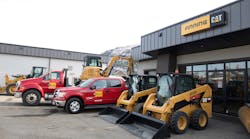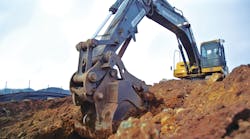By Tom Jackson
For contractors considering battery-electric powered equipment, their local rental house will likely be their first stop.
The demand for such equipment is just a trickle now, but as battery-electric costs come down and government incentives (or requirements) ramp up, the market will grow significantly. And rental gives contractors a chance to try before they buy.
Industry leadership
Canada’s largest Cooper Equipment Rentals has an inventory of $35 million in alternative fuel and energy product solutions. “We bought the first JCB 210 battery-electric excavator at the ARA show in 2019, right off the show floor,” says Rod Lentino, director of rental equipment. “We have a dozen of them now.”
The next big step for the industry as a whole will be gathering data and making the business case on cost, says Lentino. “We're not quite there yet, but we’re certainly collecting telematics data on the use of the machines,” he says. “It’s hard to tell what the cost of batteries will be in the future. I am seeing improved battery quality, run time and charge cycles. But the cost remains to be seen for us.”
Electric equipment should be seen by the industry as more than just a commodity rental, says Lentino. “We need to migrate toward a solution-based partnership with our customers. The data has to be meaningful.” And being able to document these CO2 reductions is one way Cooper Equipment Rentals can add meaningful information, he says.
Lentino says he’d like to see OEMs producing more battery-electric machines, not just demonstration machines, but models for sale. “I was a bit disappointed with this year's ConExpo show,” says Lentino. “I was there for the sole purpose of scouting new innovative products, specifically in this space of electrification. I saw a lot of prototypes and concepts, but nothing you could buy.”
Market to double
From 2023 to 2030 the sales of battery-electric mini-excavators, skid steers and compact track loaders globally could double. That’s the conclusion of a research paper authored by Alastair Hayfield, senior research director at Interact Analysis.
Although the total number of machines right now is small, Hayfield says by 2030 electric versions could make up 10 to 15 percent of the market. In the United States, 120 of these were sold in 2022. Sales by 2030 are estimated to be at around 11,500 machines per year, he says, with most likely well over a thousand being electric.
Small-scale regulation
While there are no current federal regulations on CO2 emissions from heavy equipment, the possibility exists that cities and regions may introduce their own regulations on a smaller scale. “As opposed to a top-down legislated result, it may be tempting for these smaller areas to recreate for off-road equipment what they’re doing with passenger car regulations,” Hayfield says.
London, for example, will ban all diesel vehicles in its city center in 2025 and expand the ban to the entire city by 2050. And it’s within the realm of possibility other big European and North American cities will consider banning diesel-powered construction equipment in their city centers as well, Hayfield says.
Total cost of ownership
For battery-electric earthmoving equipment, those total cost of ownership numbers have yet to come into focus. But for another category, lift and access equipment, the numbers are well established and look encouraging.
JLG has been making electrified lift and access equipment for more than 20 years. Contractors choose to rent this equipment for indoor and environmentally sensitive work primarily because of its clean, quiet operation, says Tim Morris, senior vice president of sales and market development. TCO is the second reason, says Morris, but the benefit is big.
“All-electric scissor lifts can lower overall TCO by 30 to 40 percent, a figure arrived at by reviewing thousands of rental company maintenance records and independent resale value reports,” says Morris. “Any improvement in TCO is a big win for customers. So where electrified products lower TCO, we anticipate we’ll see a continued acceleration in adoption.”
Plenty of reasons why
“As is the case with other types of equipment, the industry trend is toward electrification,” says Amalija Kopac, Genie senior product manager. “We’re seeing similar application trends for compact telehandlers and, as a result, electric and hybrid power are compelling options because of emissions concerns when equipment is used in confined spaces.”
“Demand for electrified equipment has continued to grow in the last few years,” says Zach Gilmor, Genie product manager. “I think it’s fair to say that we expect demand will continue to rise because, when implemented properly, electrified equipment can perform as well if not better than diesel equipment with less maintenance and a lower total cost of ownership.”
Batteries, Charge Time and Range Anxiety
In the last few years, one big concern in the ecosystem is the charging infrastructure, says Bob Begley, director of product management–scissor lifts at JLG.
“How will these machines be charged on-site, particularly in the early stages of construction or in remote locations where power is not readily available? It’s also important to consider when these machines will be charged. Runtime is a big deal to users. Understanding how long a machine needs to run each day to complete the work is essential,” Begley says.
Mobile power sources
The good news is that promising solutions are emerging. This year Sunbelt Rentals announced a partnership to acquire 600 of Moxion’s new mobile MP-75/600 portable batteries. The Moxion chargers are essentially a self-contained unit of high efficiency batteries that can be trailered to a jobsite and used to power a suite of electric machines for up to a week at a time. When the MP-75/600 starts to run low on juice, the battery management system will alert Moxion or Sunbelt, which will swap it out for a new, fully charged unit.
Power by the hour
Volvo Construction Equipment, which manufacturers a number of battery-electric machines, is also developing solutions for recharging in the field. The Voltstack 30k L2 e-Chargers are currently available for rent at Volvo Construction Equipment & Services in California and Ascendum Machinery in North Carolina. Hoffman Equipment, based in New Jersey, will be next to receive the units.
And this year the company will start to offer recharging as a service model. “At VCES, we’re rolling out a first-of-its-kind service called 'Green Power by the Hour' that will accelerate the adoption of electric equipment while providing flexible payment models, such as paying by the kilowatt hour rather than a monthly rental fee,” says David Hill, president, Volvo Construction Equipment & Services.
Electric with diesel backup
United Rentals is also providing jobsite power with the Powerbank in partnership with POWR2 Energy Solutions. The Powerbank portable energy storage system integrates with diesel generators, enabling the user to significantly reduce generator run-time and reduce emissions, noise and fuel waste. The system is comprised of high-density lithium batteries, inverters and load-sensing technology.
The Powerbank model designed for United Rentals is rated for 40KW to 60KW of power output and provides between 60KW and 120KW hours of storage. The system is designed to absorb fluctuations in load while providing power; then engage the diesel generator when the batteries are close to depletion.
The electric future
“Electrification is one of the megatrends of the future and businesses will have to reinvent themselves to be prepared for the future,” says JLG’s Morris.
Adoption of this technology, Morris says, has accelerated despite concerns about added cost and complexity. “Customers may have resisted these technologies in the past, but users and regulations are driving more immediate change and advances in technology have made these solutions more affordable.”
@@@@@@@@@@@@@@@@@@@@@@@@@@@@@@@@@@@@@@@@@@@@@
An Earthmoving OEM’s take on electrification
While electrification has been used in lift and access machines for two decades, earthmoving equipment manufacturers have just begun to explore the territory in the past three to four years.
Case Construction Equipment developed the industry’s first commercially available electric backhoe loader for Conexpo 2020 and just launched its first electrified mini excavator, the CX15EV, with several larger models to come soon.
“The rental market is well positioned to serve contractors who are looking to expand their offering and capitalize on the benefits that electrification offers,” says Brady Lewis, product manager, emerging products and technology at Case. “Our new EV models will be available to dealers and independent rental businesses to add to their fleets as they are released, provided they make the necessary investment in infrastructure, tooling, PPE and training to safely handle, sell and support these machines.
“The rental segment has an important role to play by giving contractors the opportunity to prove the value EV units have for their business and the jobs they work. In turn, EV models provide rental houses a significant growth opportunity as a premium product that can draw in a new customer base.”
Cost advantages
As has happened with batteries in electric vehicles, the costs on electrified equipment batteries are coming down,” says Lewis, thanks to improvements in battery technology and chemistry and increased manufacturing volume. “Many experts in the field see that trend continuing with prices falling over time.”
And Lewis thinks that battery life may not be the limiting factor on overall machine life. “There is a perception that batteries and electric components have a limited life span. However, advances in these technologies have extended battery and electrical component life much longer than many would expect — often beyond the useful life of the machine.”
Charging considerations
There is a lot of innovation and growth happening in the remote charging technology, says Lewis. With several portable power solutions now available for rent, there’s no issue with jobsite recharging. You will soon no longer need grid power to recharge your electric machines.
“In the near term, the compact and sub-compact machines are well suited for electrification because they can be easily transported and charged,” says Lewis. “Typical applications for this equipment include indoor operations or supply yards where the machine can be charged on-site. But they’re also well suited for jobs further afield because they can easily be loaded on a trailer and returned to the shop for charging.”
Total cost of ownership
EV units require less maintenance and use more affordable power than their diesel counterparts, says Lewis. The absence of oil changes, air filter replacement and after-treatment maintenance results in considerable savings. And electricity is substantially less expensive than diesel.
“All of these factors contribute to a solid return on investment that can offset the upfront cost of an EV unit,” says Lewis. “While it’s clear that the operating costs of EV units are reduced compared to diesel, the nuances of each application will affect the degree of savings and payoff time,” he says.
@@@@@@@@@@@@@@@@@@@@@@@@@@@@@@@@@@@@
New Battery-Electric Products
Manitou’s battery options cover all uses
At the American Rental Association’s annual meeting this year, Manitou launched a new line of electrified telehandlers for the North American market, part of the company’s Oxygen line of low emissions equipment.
In addition to maintaining the same performance specs as their diesel counterparts, Manitou says its new line will lower the total cost of ownership while simplifying service and making the jobsite air a little cleaner and less noisy.
The MRT 2260e and the MRT 2660e deliver 13,200 pounds of maximum capacity in a 100 percent electric machine. The 700-volt, 65-kilowatt lithium-ion battery can be supplemented with an optional second battery to double the capacity. And an optional E-Xtra Generator gives the machines hybrid capabilities as well. There is also a “plug-in” mode that allows the machine to operate while connected to the main energy supply when the stabilizers are extended.
The MT 625e is a fixed compact telehandler with a maximum capacity of 5,500 pounds, maximum reach of 19 feet 2 inches, and a maximum outreach of 11 feet 1 inches. Outfitted with either a 25 kilowatt or optional 35-kilowatt lithium-ion battery, the machine achieves a full charge in just over two hours when equipped with the optional 9-kilowatt on-board charger (3 kilowatt is standard).
“Telehandlers are perfectly suited for electrification due to their varied use throughout the day,” says Steve Kiskunas, product manager — telescopic handlers at Manitou. “And the elimination of service and support operations and costs around the diesel engines will have significant lifetime cost savings.”
Genie’s purpose-built batteries
With more than 70 percent of its products electrified, Genie continues to leverage that expertise into its latest lift and access equipment including the Lithium-Ion battery option for their GS E-drive slab scissor lifts, as well as their electric S-60 DC and hybrid S-60 FE telescopic boom lifts.
Genie lithium-Ion batteries have been specifically designed for mobile elevating work platforms, says Christian Dube, Genie global product manager. Genie’s GS E-Drive Lithium-Ion scissor lifts can be recharged in just four hours, which is 33-percent faster than a standard flooded lead acid battery, and partial charges won’t damage the Lithium-Ion battery. This allows operators to charge a lift during breaks or over lunch in the event the machine didn’t get charged the night before, or if it is being used for a second shift. The lithium-ion battery option is available globally on nearly all GS E-Drive slab scissor lifts, with the exception of the GS-1432m and GS-1932m micro scissor lifts and the GS-4046 and GS-4655 slab scissor lifts.
Genie also introduced the hybrid S-60 FE and electric S-60 DC booms in Europe in May 2022 of last year, and to North America and Latin America in December 2022. The S-60 DC is currently available in most of the Asia-Pacific region, while the S-60 FE is now available in Australia.
@@@@@
Independent systems maximize battery life in JLG’s DaVinci
Compared to a traditional machine, every component on the recently introduced 19-foot (5.79 m) all-electric DaVinci AE1932 scissor lift is optimized to reduce energy consumption by up to 70 percent including the control, lift, drive and steering systems.
Each system (lift, drive and steer) is connected independently, helping reduce voltage drops and latency. As a result, the DaVinci needs only a single, lithium-ion battery. An electro-mechanical actuator powers the lift function without the need for hydraulics or hydraulic fluid.
Permanent magnets on the DaVinci drive system generate torque and create motion to spin the motor. It is estimated that permanent magnet performance can increase the efficiency of a motor by up to 20 to 30 percent on average. Motors with permanent magnets also have a long life and require zero serviceability.
Furthermore, the DaVinci scissor lift system is engineered to recover energy as the platform descends, sending it back to the battery to help maximize use between charges. Charge time can be as little as three-and-a-half hours and the system can also be opportunity charged in five minutes or less for 100 feet (30.48 m) of drive, plus enough torque for loading. The DaVinci has a 606-pound (275 kg) capacity rating, a compact footprint, weighs 3,450 pounds (1,564.89 kg), and offers 25-percent gradeability and a 4-mph (6.44 km/h) travel speed.
JCB Electric dumpers
When it comes time to do demo work, the JCB HTD-5E E-Dumpsters offered by United Rentals can do the work indoors or out, quietly, cleanly and effectively. The tracked e-dumpster is offered as a high-tip, ride-on model, capable of carrying up to 1,102 pounds. Its lithium-ion battery pack powers the machine for a typical full day work shift. With the smart step feature, stepping off the machine isolates power to the tracks while still allowing use of the hydraulics.
Bobcat breaks barriers with T7X
Last fall a deal was announced to start offering Bobcat’s T7X all electric compact track loader in Sunbelt Rental stores in California and other markets in North America. With its 60.5KW lithium-ion battery, the T7X has no engine oil, hydraulic fluid, or coolant to change. With 50 percent fewer parts than its diesel counterpart it substantially reduces maintenance cost and time. The T7X can be charged using a 220/240V 50-amp power service in areas where accessible. And the lithium-ion batteries hold a consistent voltage for the duration of their charge.
United Rentals to offer all-electric Polaris
United Rentals is riding down a new path with the addition of all-electric Polaris Ranger XP Kinetic utility vehicles. “There used to be a concern around electric vehicles that they were less capable than their combustion engine counterparts -- and that’s just not the case anymore,” says T.J. Mahoney, vice president, supply chain, United Rentals.
The Ranger XP Kinetic’s advanced drivetrain features fewer moving parts for lower maintenance costs and more uptime. Plus, the quiet electric powertrain means easier communications with coworkers, the ability to work in the early morning without waking neighbors, and quieter operation around jobsites. It offers 110 horsepower and 140 pound-feet of instant torque for the ability to tow 2,500 pounds and haul 1,250 pounds.
The Premium trim is equipped with 14.9 kWh of lithium-ion battery capacity and offers an estimated range of up-to 45 miles, while the Ultimate trim boasts 29.8 kWh of battery capacity and offers an estimated range of up-to 80 miles. Scheduled maintenance costs are expected to be 70 percent less than the average for similar gas-powered vehicles.
Equipment Depot ramps up for electric
In June, Equipment Depot, America’s largest independently operated material handling and equipment rental source, opened up a new 75,000-square-foot facility in Romeoville, Ill.
“We required substantially more space in order to house the vast number of additional Jungheinrich electric lift trucks,” says Jonathan Hesener, Equipment Depot’s chief sales officer. “As part of our corporate vision to reach a billion dollars in revenue by 2025, we are continually looking at new areas of growth, new approaches to solve customer challenges and innovative equipment and solutions."
Tom Jackson has been writing about heavy equipment and construction for more than 30 years. He also publishes a Substack blog, Heavy Equipment Insights, that focuses on construction technology, sustainability and infrastructure.








